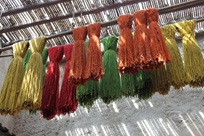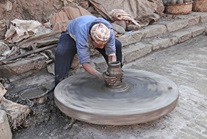Fibre to Fabric
1.What Would Happen if Clothes Were Not Stitched?
- Stitching is a skill of making a variety of clothes.
- Long unstitched clothes are not easy to manage and wear, so they are converted into suitable clothes
- for wearing.

2. What Is the Colour of Fibres Like Cotton and Silk? How Are They Coloured?
- Natural fibres like cotton and silk are white or colourless when obtained from their sources.
- They are spun to make fibres which are coloured using various dyes before they are weaved or knitted to make clothes.

3.Why Does a Potter’s Wheel Always Round and Not Square?
- As long as there is any motor or machine for spinning the wheel, the wheel's shape does not matter.
- But the wheel is circular in shape, so it can be convenient for the potter to use it. A shape with corners may be dangerous while working.

4.How Does Soft Clay Become Hard When Converted Into a Shaped Vessel?
- When a vessel made out of clay is allowed to dry, it loses water, making it hard.
- Once these vessels are heated in a kiln, all water is lost, and they become harder and long-lasting.
Share
Loading Footer...

